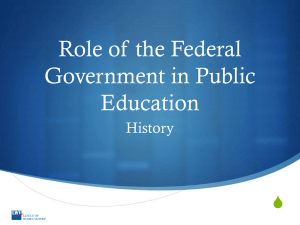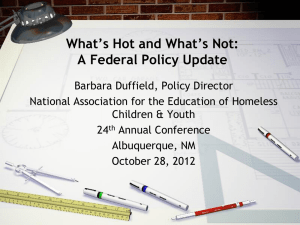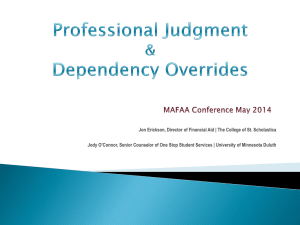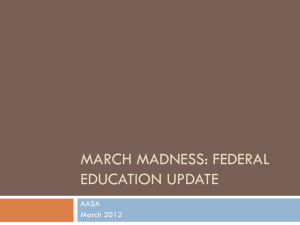Senate Committee ESEA Bill - The National Association for the
advertisement
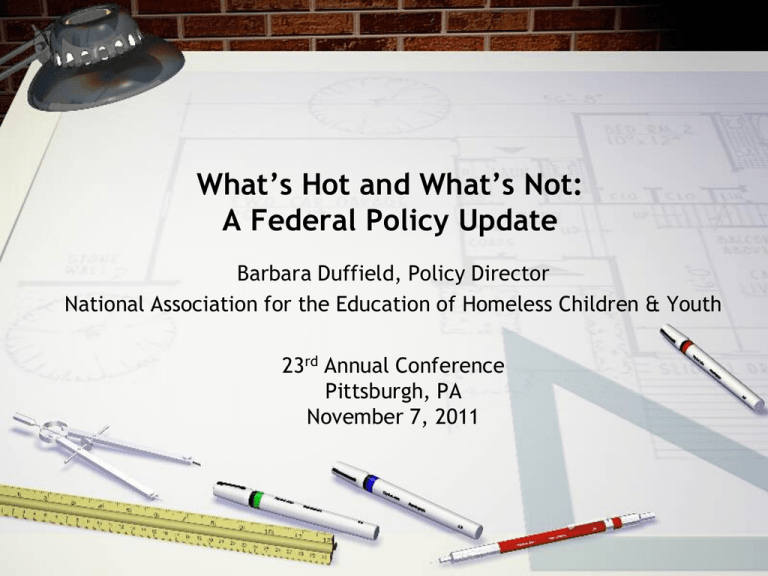
What’s Hot and What’s Not: A Federal Policy Update Barbara Duffield, Policy Director National Association for the Education of Homeless Children & Youth 23rd Annual Conference Pittsburgh, PA November 7, 2011 McKinney-Vento Funding: Current Status • Current level: $65.3 million • President’s budget: $65.3 million • This funding has not changed significantly in four years, while the number of homeless students in preK-12 has increased by 38% over the same time period • Reached 18% of all school districts nationwide with ARRRA dollars; much fewer now What about Head Start, HUD, and USDA? • Still waiting for HUD regulations on its new definition of homelessness (law passed May 2009; proposed regulations and comment period closed June 2010) • Still waiting on Head Start regulations (law passed December 2007; proposed regulations on verifying eligibility and comment period closed June 2011). • USDA interim rule on free meals (law passed in 2004; comment period closed October 2012). LIHTC and Homeless Youth Housing • Low Income Housing Tax Credit Housing • “Student Rule” – prohibits residents from living in LIHTC housing if they are full-time students • Foster youth, single mothers, parents on cash assistance are exempted from this rule • Unaccompanied homeless youth are not; forced to choose between housing and education • Congressman McDermott (D-WA) and Paulsen (R-MN) introduced legislation, H.R. 3076, that adds UHY to exemptions FY2012 Appropriations • Senate and House FY2012 Labor-HHS-Education bills passed out of Committee: level funding for EHCY • Budget climate is very difficult due to deficit reduction and pre-election politics • Still, the needs at the community and state level must be made known • www.naehcy.org/update.html McKinney-Vento EHCY Reauthorization: Legislation Introduced • Reauthorization is the opportunity to make substantive changes to the law • March 2011: S. 571, “The Educational Success for Children and Youth Without Homes Act of 2011” introduced in U.S. Senate (Murray/Franken/Begich) • March 2011: H.R. 1253, introduced in U.S. House (Biggert/Kildee/Grijalva) McKinney-Vento EHCY Reauthorization: Status Update • US Senate HELP Committee passed the “Elementary and Secondary Education Reauthorization Act of 2011” on October 20 • US House: passing smaller bills rather than one large ESEA bill. No M-V legislation yet • NAEHCY goal: to see as many S.571/HR 1253 provisions included in these bills • Unlikely to see final passage of ESEA this year, but creates starting point for next Congress Major Issues in M-V EHCY Reauthorization • McKinney-Vento Personnel: State Coordinators and Local Liaisons • School Stability Provisions (“Feasibility”) • Enrollment • Transportation • Disputes • Credits/Academic Support • Extra-curricular activities • Unaccompanied Youth • Preschool Children • Funding Level • Title I, Part A Setasides • Children and Youth in Foster Care McKinney-Vento Personnel: State Coordinators, Local Liaisons Issues: lack of time; lack of training; lack of resources Senate Committee ESEA bill: – Local liaisons designated by LEAs must have “sufficient training and time” to carry out their duties. – State coordinators must have “sufficient knowledge, authority, and time” to carry out their duties. School Selection Provisions Issues: “to the extent feasible” weakens law; problems with feeder schools Senate Committee ESEA bill: – Presumption that school of origin is in best interest, unless • Against parent/guardian/youth wishes • Best interest determination based on student-centered factors - including the impact of mobility on achievement, education, health, and safety of homeless children and youth - weighs in favor of local enrollment – The best interest determination must prioritize the wishes of parent or youth – If the LEA determines school of origin is not in the best interest, guardian, youth: written notice/appeal must be provided Enrollment Provisions Issues: fees remain a significant barrier Senate Committee ESEA bill: – Clarifies immediate enrollment, even if student owes fees or is unable to pay fees in school selected – Clarifies records must be released even if student owes fees or is not withdrawn in accordance with local procedures Transportation Provisions Issues: lack of funding creates implementation problems; subgrants don’t reach all LEAs Senate Committee ESEA bill: – Explicitly authorizes Title I Part A to be used for transportation to school of origin Academic Support, Extra-Curricular Activities Senate Committee ESEA bill: • States must have procedures to ensure that homeless children and youth who meet the relevant eligibility criteria are able to participate in Federal, State, or local beforeand after-school care, magnet schools, summer schools, career and technical education, advanced placement online learning opportunities, charter school programs, and relevant workforce investment programs. • SEAs and LEAs must adopt policies and practices to promote school success, including access to full participation in academic and extra-curricular activities that are made available to non-homeless students. Credit Accrual Issue: Youth lose credits due to mobility, late enrollment Senate Committee ESEA bill: • States must have procedures to ensure that homeless youth receive credit for coursework satisfactorily completed while attending a prior school and for work completed after their enrollment in a new school, consistent with State graduation requirements and accreditation standards. Public Notice Senate Committee ESEA bill: • Local liaisons must ensure that public notice of the educational rights of homeless children and youth is: – incorporated into documents related to residency requirements or enrollment; – provided upon school enrollment and withdrawal; – posted on the local educational agency's website; and – disseminated in locations frequented by parents or guardians of such children and youth, and unaccompanied youth, including schools, shelters, public libraries, and soup kitchens, in a manner and form understandable to parents and guardians of homeless children and youth, and unaccompanied youth. Privacy Senate Committee ESEA bill: • Schools must treat information about a homeless child or youth’s living situation as a student education record, and may not release this information to housing providers, employers, law enforcement personnel, or other persons not authorized. • Schools must pay particular attention to preventing disruption of the living situations of homeless children and youth, and supporting the safety of children and youth who are survivors of domestic violence, and unaccompanied youth. Unaccompanied homeless youth Issues: concerns about liability, FAFSA verification Senate Committee ESEA bill: • Requires local liaisons to ensure that unaccompanied homeless youth: – Are enrolled in school; – have opportunities to meet the same college and career ready State student academic achievement standards which other students are held, including through the credit accrual and school success provisions of the McKinney-Vento Act; and – are informed of their status as independent students for financial aid and receive verification for the FAFSA. • Protects school districts from liability for enrolling an unaccompanied homeless youth in accordance with the McKinney-Vento Act. Preschool Children • Issues: MV’s reach is narrow; lack of capacity, fragmented nature of early childhood programming creates barriers • Senate Committee ESEA bill: • Requires preschool programs funded, administered, or overseen by State agencies to identify and prioritize homeless preschool children for enrollment, including through reserving slots, conducting targeted outreach, waiving application deadlines, professional development, and developing the capacity to serve all homeless children Funding • Senate Committee ESEA bill: • Authorizes “such sums as may be necessary” for FY2012 and each of the six successive years. Title I Part A: Set-asides • Issues: too many “loopholes” in law; problematic interpretations from ED • Senate Committee ESEA Bill: • The setaside amount must be based on a needs assessment that includes information on child, youth and family homelessness in the LEA obtained through collaboration with other agencies, as well as the number of homeless children and youth the LEA identified the previous year. • Specifically authorizes funds reserved for homeless children and youth under Title I to be used for local liaisons, transportation to the school of origin, services for preschool children and high school students, and removing barriers to homeless students’ enrollment, attendance, retention, and success in school. Children and Youth in Foster Care Consensus: School of origin rights and immediate enrollment for foster youth should be included in ESEA (reciprocal mandates to Fostering Connections, which requires child welfare agencies to coordinate with school districts on stability and enrollment) Controversy and conflicts: • Transportation – Is it required? Who pays? • Liaisons for foster youth – Are they required? How to ensure that this requirement doesn’t result in less time, attention, and services for homeless children and youth? Children and Youth in Foster Care Senate Committee ESEA Bill: Creates a new section of Title I Part A that: • Requires State Education Agencies (SEAs) to collaborate with state child welfare agencies to ensure that: – Children and youth in foster care remain in their school of origin unless it is not in their best interest, and to be immediately enrolled in a new school if that is in their best interest; – Records are immediately transferred to a new school; – Graduation and achievement data on youth in foster care are disaggregated; and – Foster youth receive credit for work done satisfactorily in a previous school. Children and Youth in Foster Care Senate Committee ESEA Bill: • Requires SEAs to enter into an agreement with the state child welfare agency within a year of enactment to ensure that children and youth in foster care receive transportation to their schools of origin. • The agreement must describe 1) how foster care maintenance payments will be used to help fund the transportation of children in foster care to their schools of origin, and 2) how children who leave foster care will receive transportation to maintain their enrollment in their schools of origin for the remainder of the academic year, if remaining in their schools of origin is in their best interests. Children and Youth in Foster Care Senate Committee ESEA Bill: • Requires that each SEA and every LEA that receives Title I Part A funding designate an individual to serve as a point of contact for child welfare agencies. The point of contact is responsible for overseeing the implementation of the new foster care education requirements. • The foster care point of contact cannot be the McKinney-Vento homeless education coordinator, unless that individual has the capacity, resources, and time to perform both roles. • Creates a new setaside under Title I Part A for children and youth in foster care to help fund the position of LEA “point of contacts” for foster youth. Next Steps • Unclear if the bill will reach the Senate floor this Fall, or when House will act • Important to communicate concerns with legislators • For legislative emails, send email request to bduffield@naehcy.org (or give me your card/paper with email address) • For web updates: www.naehcy.org/update.html



